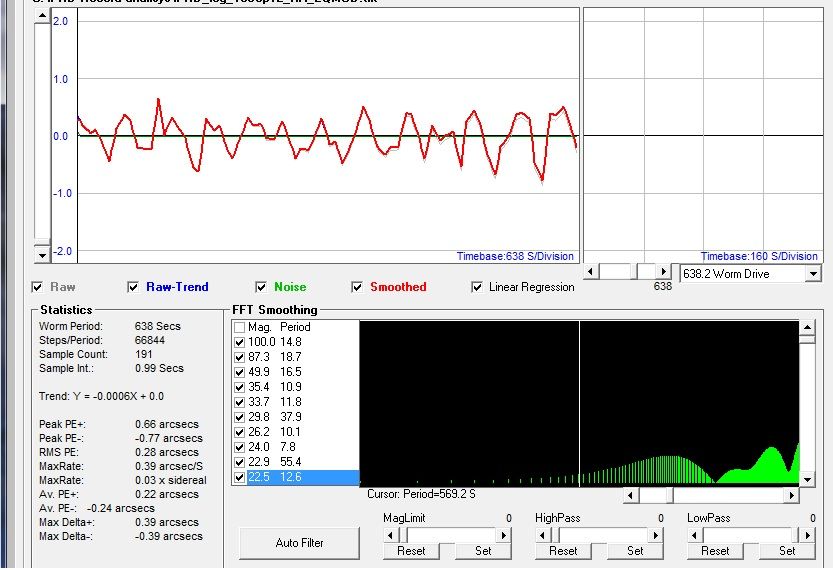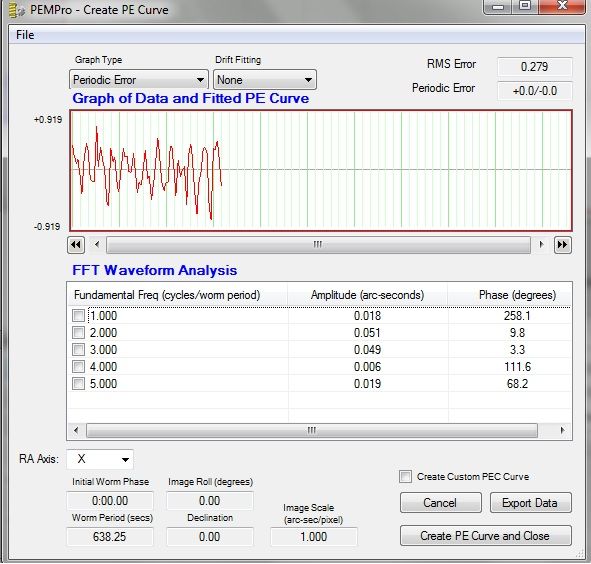Portable Telescope Trolley
Re: Portable Telescope Trolley
Last night i tracked this mount to do some test on autoguider. actually i used it for more then an hour to take some m45 pics, i don't know why it showing only 3+ min tracking sample. here is the PE.


-
superiorstream
- Posts: 1504
- Joined: Mon Nov 03, 2008 4:45 pm
Re: Portable Telescope Trolley
Hi,Kimo
Good to hear that you are trying.Never say die--thats the spirit.Good also to see that you are now using your 10 inch.Keep it up!
Good to hear that you are trying.Never say die--thats the spirit.Good also to see that you are now using your 10 inch.Keep it up!
- orly_andico
- Posts: 1616
- Joined: Sun Aug 09, 2009 11:14 pm
- Location: Braddell Heights
- Contact:
Re: Portable Telescope Trolley
That error is almost certainly while auto-guiding. That's why you can see in the period field (with the check boxes), there is no component with a 638-second period (which would be the fundamental of the worm - since the HEQ5 has a 135-tooth worm wheel, one rotation is 86164 seconds / 135 teeth = 638 seconds). All of the time bases are small (<60 seconds) which means they are either seeing artifacts or gearbox noise.
To measure the mount's actual periodic error auto-guiding needs to be turned off; you need to use the PEMPro calibrate wizard as well to compensate for the star declination (or, alternatively when importing into PECPrep, you have to check the button "compensate for star declination" and input the star's declination in the little box).
The reason for this is because a star at the celestial equator (declination = 0) will show the greatest periodic error, while a star at the pole (declination = 90) will show no error. The actual error is the measured error (from the PHD log) divided by the cosine of the declination.
The only mounts that can provide <2 arc-second peak-to-peak periodic error without auto-guiding have names like Astro-Physics and Software Bisque.
To measure the mount's actual periodic error auto-guiding needs to be turned off; you need to use the PEMPro calibrate wizard as well to compensate for the star declination (or, alternatively when importing into PECPrep, you have to check the button "compensate for star declination" and input the star's declination in the little box).
The reason for this is because a star at the celestial equator (declination = 0) will show the greatest periodic error, while a star at the pole (declination = 90) will show no error. The actual error is the measured error (from the PHD log) divided by the cosine of the declination.
The only mounts that can provide <2 arc-second peak-to-peak periodic error without auto-guiding have names like Astro-Physics and Software Bisque.
Re: Portable Telescope Trolley
Thanks orly. very informative text. Yes, i do know have to turn off the guider drive. i tried to understand the guider working perfectly as i modified the guider port. it is not HEQ5, it is GP2.